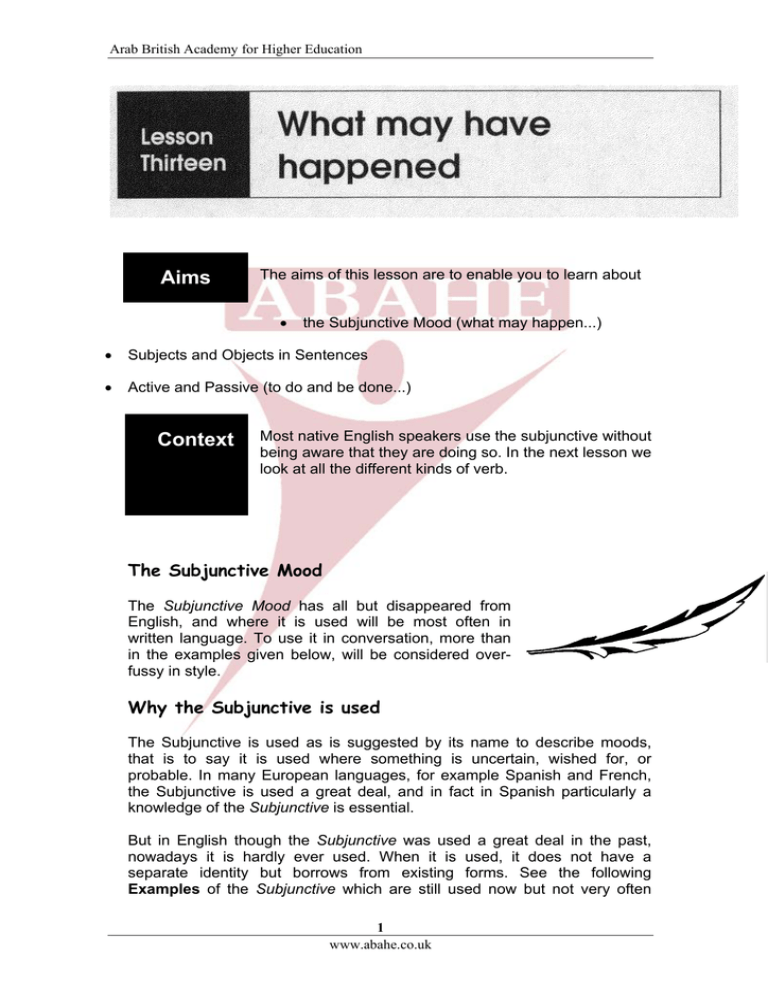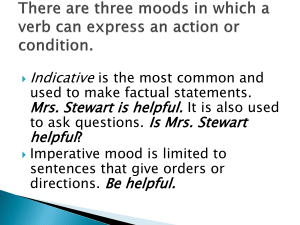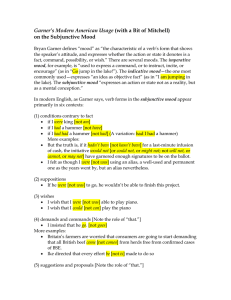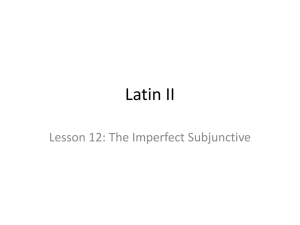
Arab British Academy for Higher Education
Aims
The aims of this lesson are to enable you to learn about
the Subjunctive Mood (what may happen...)
Subjects and Objects in Sentences
Active and Passive (to do and be done...)
Context
Most native English speakers use the subjunctive without
being aware that they are doing so. In the next lesson we
look at all the different kinds of verb.
The Subjunctive Mood
The Subjunctive Mood has all but disappeared from
English, and where it is used will be most often in
written language. To use it in conversation, more than
in the examples given below, will be considered overfussy in style.
Why the Subjunctive is used
The Subjunctive is used as is suggested by its name to describe moods,
that is to say it is used where something is uncertain, wished for, or
probable. In many European languages, for example Spanish and French,
the Subjunctive is used a great deal, and in fact in Spanish particularly a
knowledge of the Subjunctive is essential.
But in English though the Subjunctive was used a great deal in the past,
nowadays it is hardly ever used. When it is used, it does not have a
separate identity but borrows from existing forms. See the following
Examples of the Subjunctive which are still used now but not very often
1
www.abahe.co.uk
Arab British Academy for Higher Education
today.
Examples
a) If I were you, I would not go in there!
Here were is neither a Past Tense nor a Plural, as can be seen from the if I
before it, and the Conditional verb in the Subordinate Clause (n.b. for more
about Subordinate Clauses, see the previous Lesson)
This is our form of the Subjunctive, used to express doubt and uncertainty;
i.e. there is no clear statement being made, but it is basically a conditional
or hypothetical statement! (what might happen if...)
b) Let there be light
This Subjunctive has two parts, let + be; (be is the actual Subjunctive form,
let forming the other half of what is in fact an Indirect Command) (See
Lesson Fourteen on Different Types of Verbs with special reference to
Commands...)
c) Long live the Queen:
live is again in the Subjunctive and is another Indirect Command: it is short
for: Let the Queen live long
n.b.
Let as in “Let there be light” can be replaced by may; (we
saw may previously as a modal verb in the previous Lesson); you can also
say equally “Long may the Queen live...”
The Form of the Subjunctive
This is very easy; in the Past Tense it is usually the same as the simple Past
Tense; the exception is were as in: If I were you...
Example
If I had enough money, I would buy that house
If my friends came, they would be very welcome
The Present Subjunctive
This hardly exists except in such forms as: Long live the Queen
However by adding the modal form may a Present Subjunctive can be
created:
2
www.abahe.co.uk
Arab British Academy for Higher Education
E.g. It is possible he may come
I do hope you may like this
But as indicated, this is rather rare, and only used in literary contexts, not in
every day conversation!
But on the whole apart from the above examples e.g. long live
the king, may and let + the verb, you can say there is
effectively no Present Subjunctive as a separate form in
English. We have on the whole removed it as an unnecessary
part of our language - unlike many other languages which still
keep it.
May
Before we come to the First Activity, it would best to look at the Auxiliary or
Modal Verb may; it has a number of meanings and uses:
a) To express doubt and is part of the Present Subjunctive.
Examples
It may rain today
They may not be the best team in the world
b) To express an order and is also part of the Present Subjunctive, but with
a different meaning.
Examples
May you go!
Long may he stay with us!
Please note: God save the Queen = May God save the Queen!
Long live the Queen = May the Queen live long!
All these are forms of the Subjunctive, which while continuing always to
express doubt or uncertainty, shows this in a number of ways, the
command being one of them, which though not apparently doubtful, has in
fact a certain amount of doubt. You can order someone to do something, but
that does not guarantee the action will actually be done; an order is a
desired action, not an action!... (See Lesson Fourteen for Commands)
These examples are quite old fashioned, and little used these days: even so
it is useful to have a look at them in order to be aware of the various
meanings of may. The final main use of may is the following: (looked at
3
www.abahe.co.uk
Arab British Academy for Higher Education
earlier)
c) To express permission and is an alternative to can...
Examples
You may go!
They may come if they wish
Now we come to the first Activity which practises the use and recognition of
the Subjunctive in English; as usual you have the Key after this Lesson.
Activity
1
Complete the following sentences with the appropriate form of
the Subjunctive: there may be more than one answer!
a) We would go to Spain if we ______ enough money!
b) Long ________ the President; ______ he govern us wisely!
c) Let him _____! He’s doing no harm!
d) If he _____ me, he wouldn’t let them speak to him like that!
e) ______ you always think as I do! (Old Fashioned)
f) You _____come and see me whenever you like!
g) The only thing we expect of you is that you _____cooperative.
h) I am not certain, but Mary ____ be here in the next quarter
of an hour.
All Rights Reserved © Arab British Academy for Higher Education
4
www.abahe.co.uk






